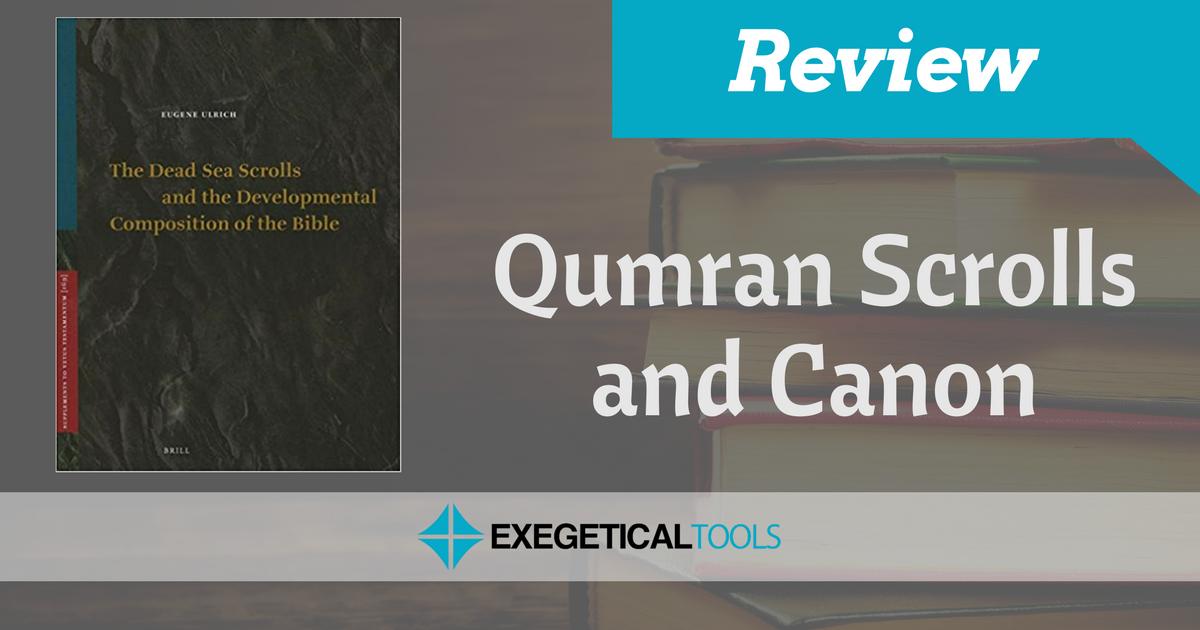
The Dead Sea Scrolls and the Developmental Composition of the Bible, by Eugene Ulrich (Brill, 2015), 346 pp.
This volume is the follow-up to Ulrich’s The Biblical Qumran Scrolls: Transcriptions and Textual Variants (Supplements to Vetus Testamentum). The former volume laid out the textual evidence from the Qumran scrolls, while this latter volume synthesizes the evidence via analysis and draws conclusions about the pluriformity of the manuscript traditions.
The volume is rather comprehensive and covers many important matters. Overall, Ulrich argues that the Qumran scrolls provide us evidence of a fluid textual tradition of the Hebrew Bible, with different types of additions, such that “the biblical text developed in the Second Temple period was through successive revised and expanded editions of each book, with the process ans the timing different for each book or set of books” (41). He suggests four different types of additions that can be found throughout the scrolls (41-44):
- Revisions or expansions resulting in new editions;
- Scribal insertions of information;
- Individual textual variants;
- Developing orthography.
The rest of the volume examines many different Qumran biblical texts and compares them with other early version and then draws conclusions from these analyses. The second part of the book examines texts from Joshua (first entering the Promised Land), a short text from Judges and a longer text from Kings, the Samuel Scrolls, Isaiah a & b, the notorious issue of Jeremiah, and the Septuagint scrolls. Ulrich traces these four proposed types of additions throughout each of these scrolls, supporting his argument for the pluriformity of the scriptural tradition.
In the third part of the book, Ulrich draws conclusions from his analyses. Variants should not be considered sectarian at Qumran, but are rather a typical part of scribal additions and revisions that were made in the Second Temple period. These types of revisions bring up the question of “rewritten Scripture,” and what qualifies as such, so Ulrich provides a useful discussion of the boundaries between pre-Scripture, Scripture (rewritten), and rewritten Scripture. This chapter is important for Qumran scholars, as much has been written on this phenomenon.
When it comes to defining canon, Ulrich suggests we should consider the book, rather than individual text-forms within the book, to be canonical. This might provide a way forward for those who agree with Ulrich’s conclusions. Even if the Pentateuch contains additions and revisions by later generations, even those in the Second Temple period, the Pentateuch itself can still be canonical Scripture. Ulrich concludes with other thoughts on the authority of Scripture and some thoughts on which books were considered authoritative at Qumran.
Overall Ulrich’s analysis in both volumes is extremely important. The textual data he organizes for us in his first volume is useful to any scholar of any persuasion. The analyses in this second volume are useful insofar as Ulrich is a master of the data. There are always still methodological and perspectival differences to consider in the evaluation of such data, though. For example, it would serve the student well to read the review of Jobes and Silva’s Invitation to the Septuagint by James Barr in the RBL Review, followed by the response of Jobes and Silva (at the end of the same PDF). When Barr asserts that Jobes and Silva made a misstatement by referring to Isaiah a rather than Isaiah b when asserting that Isaiah a has “essentially the same Hebrew text as found in Codex Leningradensis.” Jobes and Silva responded,
Actually, we do mean the A scroll, and the fact that he thinks we have made a mistake may be a clue to where are our real differences lie. While it is of course true that the A scroll contains many important variants (a few of which are reflected in the LXX), the point at issue is whether this scroll—once we set aside obvious errors by the scribe of that document, as well as orthographic/morphological variations that do not affect the sense—gives evidence of an underlying consonantal text that is essentially different from the MT. Most assuredly not.
In much the same way, the reader must be impressed with Ulrich’s facility in the evidence of the scrolls, but there are many fundamental assumptions that go into extrapolating from this data the conclusion that, e.g., “the text of the Pentateuch developed in numerous types of ways during the Second Temple period” (45). As Ulrich admits here, “most of the evidence is lost,” but he continues that “enough remains to give some detailed description of that development” (45).
Personally, I’m not sure the evidence Ulrich examines does enough to tell us about additions and revisions of texts earlier than the Qumran scrolls–texts which we do not have. Using early versions and the Qumran scrolls themselves to hypothesize earlier Hebrew text-forms does not give us certain results.
In sum, Ulrich’s volume is an important one for textual criticism of the OT and for Qumran studies, but one should evaluate closely one’s own methodology for extrapolating conclusions from the evidence.
Preview or buy Ulrich’s volume on Amazon.

One comment